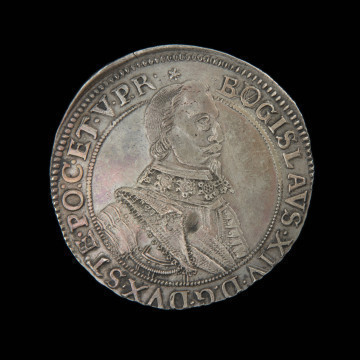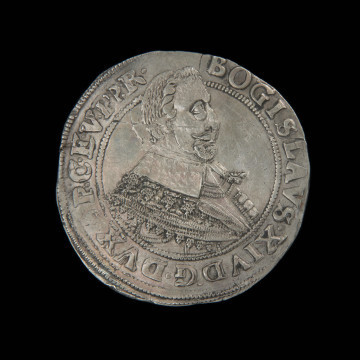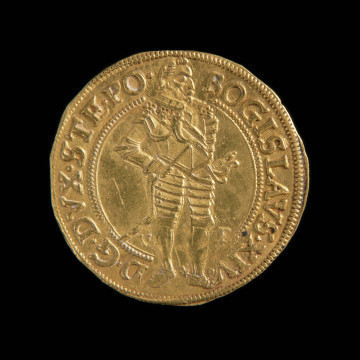
Thaler
1631
National Museum in Szczecin
Part of the collection: Pomeranian coins
The Thirty Years' War (1618-1648) and the occupation of West Pomerania by imperial troops (from 1627) forced Duke Bogislaw XIV to produce thalers continuously. The Duchy, as part of the Reich, despite its policy of neutrality, had to pay a war tax (over 83 thousand thalers), and the maintenance of the occupying army cost millions. Silver seized from churches, manors and even from the princely treasury was converted into coins. The drama of the situation was that the production aimed at maintaining a foreign army and not at improving the finances of the Duchy. Thalers were minted between 1628 and 1637 in two mints, in Szczecin and Koszalin. It is assumed that the Koszalin thalers were made with an additional bishop's title and a shield with a cross (the symbol of the bishopric) placed in a multipole shield. Nonetheless, there are many exceptions and the lack of written sources on the functioning of mints after 1629 in many cases makes it impossible to indicate the mint. The situation is also complicated by the signature of a goldsmith and engraver from Szczecin, Gottfried Tabbert, often appearing on thalers from both mints. This talented engraver developed his style, which can be seen on unsigned thalers. It is evident in the specimens minted in 1654 to commemorate the solemn funeral of Duke Bogislaw XIV. The title and the bishop's coat of arms on the thaler in question point to Koszalin as the place of production. The composition is correct but lacks lightness, the Duke's head is too big and overwhelms the shot, and the shield with the coat of arms in a full-frame can barely fit in the field. For this reason, there is no room for an inner border separating the legend from the heraldic composition. The minting of thalers on such a large scale, with an assumed yield of one pair of stamps for 10-15 thousand coins, required the employment of several engravers. Lack of documents means that we do not know any other engravers apart from Tabbert. It should be remembered that except thalers, parts of thalers and golden ducats were also minted until 1636. After the death of Duke Bogislaw XIV in 1637, both mints were closed, the one in Koszalin was closed forever, and the one in Szczecin was opened 17 years later to mint coins to commemorate the solemn funeral of the last Pomeranian ruler.
Genowefa Horoszko
Other names
Taler
Author / creator
Dimensions
cały obiekt: height: 2.7 mm
Object type
coin
Technique
minting
Material
silver
Creation time / dating
Creation / finding place
Owner
National Museum in Szczecin
Identification number
Location / status

1631
National Museum in Szczecin

1635
National Museum in Szczecin

1633
National Museum in Szczecin
DISCOVER this TOPIC
Museum of King Jan III's Palace at Wilanów
DISCOVER this PATH
Educational path